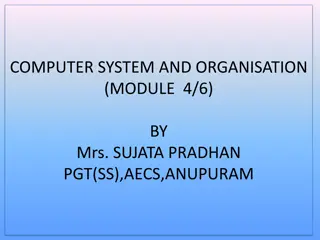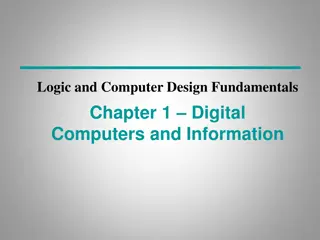Understanding Binary Numbers and Computer Data Representation
A computer stores information digitally as binary numbers, where data is broken down into pieces and represented as numbers. The binary system uses 0s and 1s to encode information, with each bit representing on/off states. This system is crucial for converting data into machine language. Binary numbers are fundamental in computer science, forming the basis for digital communication and data processing. Understanding binary, hexadecimal, and octal systems is essential for comprehending how computers interpret and manipulate data efficiently.
Download Presentation

Please find below an Image/Link to download the presentation.
The content on the website is provided AS IS for your information and personal use only. It may not be sold, licensed, or shared on other websites without obtaining consent from the author. Download presentation by click this link. If you encounter any issues during the download, it is possible that the publisher has removed the file from their server.
E N D
Presentation Transcript
AP: Discuss with a shoulder partner these questions. AP: Discuss with a shoulder partner these questions. EQ Question EQ Question: 1. What does the computer understand? 2. How is information converted to machine language? 3. What is binary? 4. What is hexadecimal? 5. What is octal?
Digital Information A computer stores information digitally as binary numbers. numbers text graphics and images video audio program instructions In some way, all information is digitized - broken down into pieces and represented as numbers
Binary Numbers Binary number system has only two digits 0 and 1 A single binary digit (0 or 1) is called a bit A single bit can represent two possible states, like a light bulb that is either on (1) or off (0) Binary is Base 2 number system so there are 2Npermutations of N bits It takes 8 bits to make a byte or a character that represents a form of data.
Ascii Code http://sticksandstones.kstrom.com/appen.html http://www.ascii.cl/conversion.htm
Bit Permutations Therefore, N bits are needed to represent 2N unique items 21 = 2 items 1 bit ? 2 bits ? 22 = 4 items 23 = 8 items 24 = 16 items 25 = 32 items 26 = 64 items 27 = 128 items How many items can be represented by 3 bits ? 4 bits ? 5 bits ? 6 bits ? 7 bits ? 28 = 256 items 8 bits ? 5
Bit Permutations Each additional bit doubles the number of possible permutations 1 bit 2 items 0 1 2 bits 4 items 00 01 10 11 3 bits 8 items 000 001 010 011 100 101 110 111 4 bits 16 items 0000 0001 0010 0011 0100 0101 0110 0111 1111 1000 1001 1010 1011 1100 1101 1110 23 Question: 3 bits can represent how much data? 8 6
What is Binary The word binary means two. The binary number system has two symbols: 0 and 1. When we write binary numbers we use a 2 for a subscript to represent the binary system. A bit (short for binary digit ) is the smallest piece of data that a computer knows. It is a single digit, which can be a one or a zero. A word is a group of any number of bits. A byte is a group of 8 bits, You would have 256 different combinations if you wrote down all the different possible combinations of ones and zeros that could make up a byte. One on Zero off Add up the place value for everyone 1. 27 26 25 24 23 128 64 32 16 8 1 0 1 0 1 0 0 1 1 0 0 0 1 1 1 0 1 1 0 0 1 1 1 0 1 1 1 1 0 0 22 4 0 0 0 0 1 0 21 2 0 1 0 1 1 0 20 1 1 0 0 0 0 1 Answer
Binary to Decimal Mathematical Equation to convert from Binary to Decimal Binary to Decimal Find the place value for everyone. Multiple 1 by that place value. 1 0 1 0 27 26 25 24 1 x 27 1 x 25 1 x 23 1 x 20 = 128 + 32 + 8 + 1 = 169 Converter Tool with explanation. http://acc6.its.brooklyn.cuny.edu/~gurwitz/core5/nav2tool.html Cisco Binary Game: Practice: 1 23 0 22 0 21 1 20 Convert 1100011 to decimal
From Binary to Hexadecimal Hexidecimal, or base 16, number system is a common system used with computers. It is a human-friendly representation of binary-coded values in computing and digital electronics. It is used in web pages for colors. Hexadecimal is represented by 16 digits 0-9 and then A F A = 10, B = 11, C = 12, D = 13, E = 14, F = 15 Converting Binary to Hex 10001100101001 STEP ONE: Take the binary number and from right to left, group all placeholders in groups of 4. Add leading zeros, if necessary: 0010 0011 0010 1001 2 STEP TWO: Convert each triplet to its single-digit octal equivalent. (HINT: For each group of 4, the hex conversion is the same as converting to a decimal number): 0010 0011 0010 1001 2 2 3 2 9 hex 2329 16
Convert from Hex to Binary 2329 16 STEP ONE: Take each hex digit and convert each digit to a binary form. Keep leading zeros: 0010 0011 0010 1001 2329 16 =10001100101001
Octal - Base 8 Numbering System The octal, or base 8, number system is a common system used with computers. Because of its relationship with the binary system, it is useful in programming some types of computers. Converting Binary to Octal Take the binary number 10001100101001 STEP ONE: Take the binary number and from right to left, group all placeholders in group of 3. Add leading zero at end if necessary: 010 001 100 101 001 2 STEP TWO: Find the binary number for that group of 3. 010 001 100 101 001 2 2 1 4 5 1 oct 10001100101001 = 21451 8
43520 8 Bring the numbers the binary group of 3 4 3 5 2 0 100 011 101 010 000 100011101010000 = 43520 oct
Convert any base to decimal by multiplying (8 x 101 ) + (9 x 100) = 89 Base 10 Base 2 Base 16 Base 8 Decimal 89 (1 * 26) + (1 * 24) + (1 * 23) + (1 * 20) = 89 (5 * 161)+ (9 * 160) = 89 Binary 1011001 Hexade cimal Octal 59 (1 * 82) + (3 * 81+ (1 * 80) = 89 131
With a partner (one with prior programming and the other with none or little) SNAP Exercises #1 - Moving and Talking (see ppt slide #8) SNAP Exercises #2 - Squares (see ppt slide #10) SNAP Exercises #3 - Triggers (see ppt slide #12) SNAP Exercises #4 - Threads (see ppt slide #14) SNAP Exercises #5 - Loops (see ppt slide #20) SNAP Exercises #6 - Input (see ppt slide #24) SNAP Exercises #7 - Arithmetic (see ppt slide #26) SNAP Exercises #8 - Conditionals / Boolean (see ppt slide #32) SNAP Exercises #9 - Events - MarcoPolo (see ppt slide #34) SNAP Project - Turtles Go to my website and start on the SNAP programming exercises. Go through the powerpoints and do each of the exercises listed. SNAP Website PPT for SNAP Project All programs have 3 basic control structures: Sequential, Condtional, Iteration (loop)























